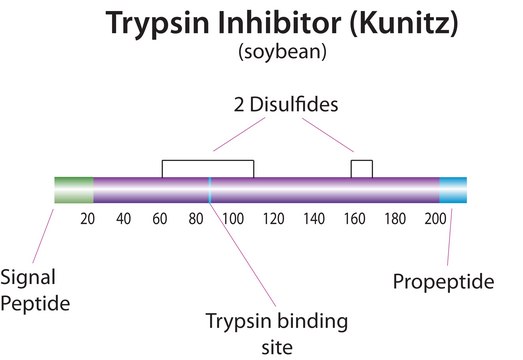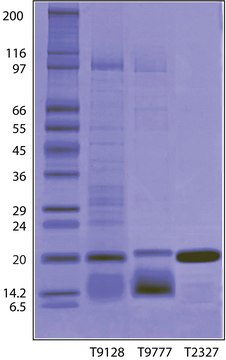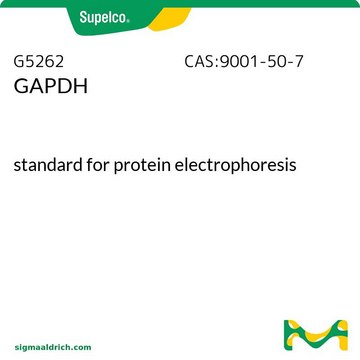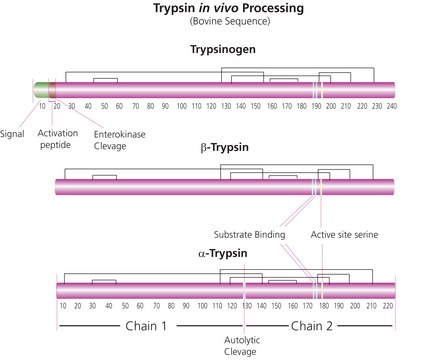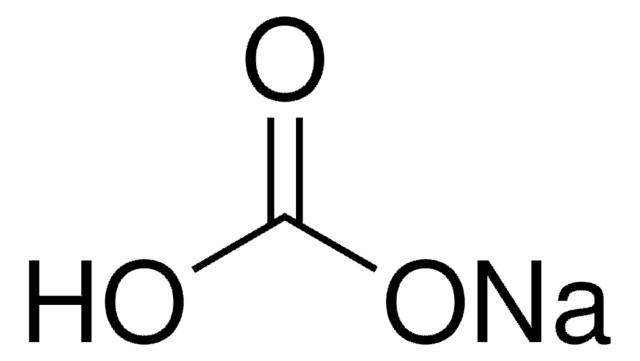T9767
Trypsin inhibitor
powder, suitable for electrophoresis
Synonym(s):
SBTI
Select a Size
CN¥650.82
Available to ship onApril 14, 2025Details
Select a Size
About This Item
CN¥650.82
Available to ship onApril 14, 2025Details
Recommended Products
Product Name
Trypsin inhibitor from Glycine max (soybean), BioReagent, For use as a marker in SDS-PAGE
biological source
Glycine max (soybean)
Quality Level
product line
BioReagent
form
powder
mol wt
20,000 Da
packaging
vial of 5 mg
technique(s)
electrophoresis: suitable
solubility
balanced salt solution: 1 mg/mL
concentrate: >10 mg/mL, hazy, amber-yellow
phosphate buffer: 10 mg/mL
water: 10 mg/mL
serum-free medium: soluble
shipped in
ambient
Looking for similar products? Visit Product Comparison Guide
1 of 4
This Item | S8761 | PHR3591 | 31437M |
|---|---|---|---|
| assay 99.5-100.5% | assay - | assay - | assay ≥99.7% |
| solubility water: soluble 100 mg/mL | solubility - | solubility - | solubility H2O: 0.5 g/10 mL, clear, colorless, water: soluble 50 g/L |
| Quality Level 300 | Quality Level 400 | Quality Level 300 | Quality Level - |
| grade for molecular biology | grade - | grade certified reference material, pharmaceutical secondary standard | grade ACS reagent, puriss. p.a. |
| pH 6.8-7.4 | pH 7.8-8.2 | pH - | pH ≤8.6 (20 °C, 5%) |
Application
Biochem/physiol Actions
Components
Unit Definition
Preparation Note
Solutions can retain activity when stored short-term at 2-8° C. Solutions are stable in frozen aliquots at -20°C.
Application
related product
Signal Word
Danger
Hazard Statements
Precautionary Statements
Hazard Classifications
Resp. Sens. 1 - Skin Sens. 1
Storage Class Code
11 - Combustible Solids
WGK
WGK 3
Flash Point(F)
Not applicable
Flash Point(C)
Not applicable
Personal Protective Equipment
Regulatory Information
Choose from one of the most recent versions:
Certificates of Analysis (COA)
Don't see the Right Version?
If you require a particular version, you can look up a specific certificate by the Lot or Batch number.
Already Own This Product?
Find documentation for the products that you have recently purchased in the Document Library.
Which document(s) contains shelf-life or expiration date information for a given product?
If available for a given product, the recommended re-test date or the expiration date can be found on the Certificate of Analysis.
How do I get lot-specific information or a Certificate of Analysis?
The lot specific COA document can be found by entering the lot number above under the "Documents" section.
How do I find price and availability?
There are several ways to find pricing and availability for our products. Once you log onto our website, you will find the price and availability displayed on the product detail page. You can contact any of our Customer Sales and Service offices to receive a quote. USA customers: 1-800-325-3010 or view local office numbers.
What is the Department of Transportation shipping information for this product?
Transportation information can be found in Section 14 of the product's (M)SDS.To access the shipping information for this material, use the link on the product detail page for the product.
What is the molecular weight and amino acid sequence of trypsin inhibitor from Glycine max (soybean)?
Soybean trypsin inhibitor is a mixture of the three types. We have not characterized our trypsin inhibitor products in terms of how much of each of the three types may be present. All three have a molecular weight of between 20,000 and 20,200 daltons, so one might use 20,100 daltons as an average.The three types vary in the amino acids at a few positions. The detailed summary of the three types (or variants) was published in the following linked reference: J. Biochem. (Japan), 98, 435-448 (1985).Note that the authors use Tia, Tib and Tic to indicate the three variants.
My question is not addressed here, how can I contact Technical Service for assistance?
Ask a Scientist here.
Articles
For use as a marker in SDS-PAGE; Albumin from chicken egg white, For use as a marker in SDS-PAGE; L-Lactic Dehydrogenase from rabbit muscle, Type XI, lyophilized powder, 600-1,200 units/mg protein
Protocols
Natural trypsin inhibitors (serpins) regulate protein activation and catabolism by inhibiting serine proteases in vivo.
Chromatograms
application for HPLCOur team of scientists has experience in all areas of research including Life Science, Material Science, Chemical Synthesis, Chromatography, Analytical and many others.
Contact Technical Service